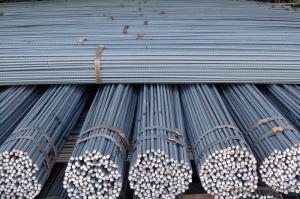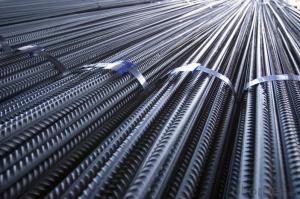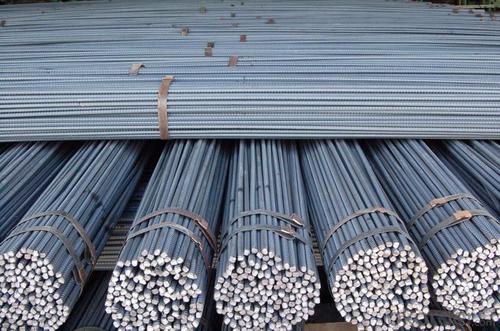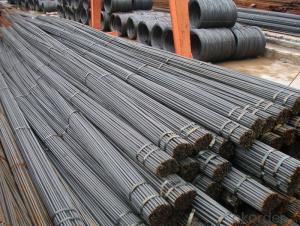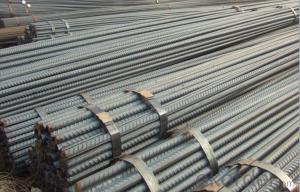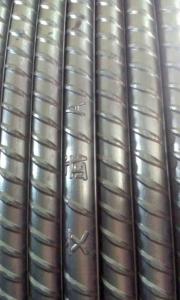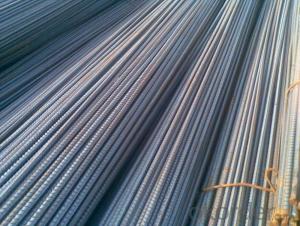Hot Rolled Carbon Steel Rebar 14mm with High Quality
- Loading Port:
- China Main Port
- Payment Terms:
- TT or LC
- Min Order Qty:
- 25 m.t.
- Supply Capability:
- 10000 m.t./month
OKorder Service Pledge
OKorder Financial Service
You Might Also Like
Product Description:
OKorder is offering Hot Rolled Carbon Steel Rebar 14mm with High Quality at great prices with worldwide shipping. Our supplier is a world-class manufacturer of steel, with our products utilized the world over. OKorder annually supplies products to European, North American and Asian markets. We provide quotations within 24 hours of receiving an inquiry and guarantee competitive prices.
Product Applications:
Hot Rolled Carbon Steel Rebar 14mm with High Quality is widely used in buildings, bridges, roads and other engineering construction. Big to highways, railways, bridges, culverts, tunnels, public facilities such as flood control, dam, small to housing construction, beam, column, wall and the foundation of the plate, deformed bar is an integral structure material. With the development of world economy and the vigorous development of infrastructure construction, real estate, the demand for deformed bar will be larger and larger..
Product Advantages:
OKorder's Hot Rolled Carbon Steel Rebar 14mm with High Quality are durable, strong.packed and suitable for construction
Main Product Features:
· Premium quality
· Prompt delivery & seaworthy packing (30 days after receiving deposit)
· Can be recycled and reused
· Mill test certification
· Professional Service
· Competitive pricing
Product Specifications:
Manufacture: Hot rolled
Grade: HRB335 HRB400 BS4449 Grade460 ASTM Grade40 Grade60
Certificates: ISO, SGS, BV, CIQ
Length:6m 8m 9m 12m
Packaging: Export packing, packed by coil
FAQ:
Q1: Why buy Materials & Equipment from OKorder.com?
A1: All products offered byOKorder.com are carefully selected from China's most reliable manufacturing enterprises. Through its ISO certifications, OKorder.com adheres to the highest standards and a commitment to supply chain safety and customer satisfaction.
Q2: How do we guarantee the quality of our products?
A2: We have established an advanced quality management system which conducts strict quality tests at every step, from raw materials to the final product. At the same time, we provide extensive follow-up service assurances as required.
Q3: How soon can we receive the product after purchase?
A3: Within three days of placing an order, we will begin production. The specific shipping date is dependent upon international and government factors, but is typically 7 to 10 workdays.
Q4: Can you supply the Rebar according to the standard KS?
A4: Yes, we can supply SD400 and SD500
Q5: How to avoid the rust after deliver the goods to the loading port?
A5: We will keep the goods at the port covered with water-proof material
Images:
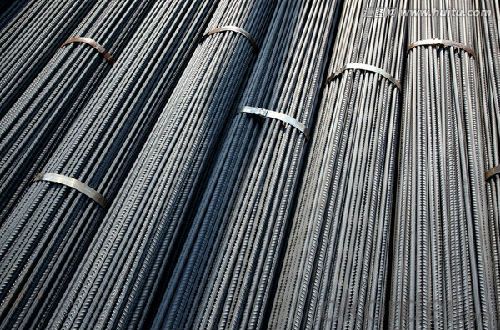
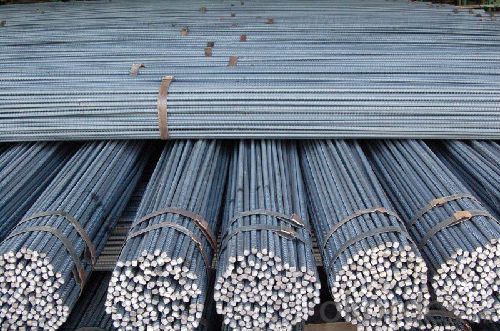
- Q: How are steel rebars installed in construction projects?
- Steel rebars are installed in construction projects by first determining the required length and size of the rebars. Then, the rebars are cut to the appropriate lengths and bent into the desired shapes. They are then placed and secured within the concrete forms or structures, ensuring proper spacing and alignment as specified in the construction plans. Finally, the rebars are tied together using wire or mechanical connectors to create a strong reinforcement framework before the concrete is poured or applied.
- Q: What is the impact of steel rebars on the overall carbon footprint of a construction project?
- Steel rebars have a significant impact on the overall carbon footprint of a construction project. The production of steel involves high energy consumption and emits a substantial amount of greenhouse gases. However, steel rebars are essential for reinforcing concrete structures, which have a long lifespan and can contribute to the sustainability and durability of a building. To mitigate their carbon impact, using recycled steel rebars and optimizing their design and placement can help reduce the overall carbon footprint of a construction project.
- Q: How are steel rebars marked for identification on construction sites?
- Various methods are commonly used to mark steel rebars for identification on construction sites. The primary method involves attaching tags or labels to the rebars, which contain crucial information like the rebar's diameter, grade, length, and any necessary specifications or codes. In addition to tags, rebars can also be marked with paint or ink. This can be achieved by either spraying or stenciling the required information directly onto the rebar's surface. Paint or ink markings are typically used for temporary identification or when using tags is not feasible. Another marking method involves using colored plastic or vinyl caps on the ends of the rebars. These caps are usually color-coded to indicate different characteristics, such as rebar size or type. This allows for easy visual identification on the construction site. It's important to note that the specific method of marking rebars may vary based on local regulations, project requirements, or the preferences of the construction company or engineer. The purpose of these markings is to ensure that rebars can be easily identified and sorted during construction, promoting proper installation and adherence to design specifications.
- Q: What is the process of reinforcing concrete walls with steel rebars?
- The process of reinforcing concrete walls with steel rebars involves several steps to ensure the strength and integrity of the structure. Firstly, the design and layout of the rebars is determined by engineers based on the specific requirements of the wall. This includes the diameter, spacing, and placement of the rebars. Once the design is finalized, the construction of the concrete wall begins. The rebars are typically placed in a grid-like pattern within the formwork or molds. They are positioned at predetermined intervals and secured in place using wire ties or other fastening methods. During the pouring of the concrete, the rebars are completely encased within the mixture. This ensures that the concrete and steel work together to resist tension forces and provide added strength to the wall. After the concrete has been poured and cured, the rebars become an integral part of the structure. They act as a reinforcement by absorbing and distributing the tensile forces that may occur due to external loads or environmental factors. In addition to the initial reinforcement, construction workers may also install vertical rebars along the height of the wall, commonly known as wall ties. These rebars provide further stability and prevent the wall from cracking or collapsing under pressure. Overall, the process of reinforcing concrete walls with steel rebars involves careful planning, precise placement, and proper integration between the rebars and the concrete. This reinforcement technique significantly increases the strength and durability of the walls, making them capable of withstanding greater loads and ensuring the safety of the structure.
- Q: Can steel rebars be used in the construction of dams or reservoirs?
- Indeed, dams or reservoirs can utilize steel rebars in their construction. It is customary to employ steel rebars as reinforcement in concrete structures, such as dams and reservoirs, to bestow them with robustness and steadfastness. These rebars serve to evenly distribute and combat the tensile forces that may arise within these structures due to water pressure and external burdens. Steel rebars possess resistance to corrosion, durability, and commendable tensile strength, rendering them a perfect choice for such purposes. Moreover, their malleability and ease of installation grant flexibility in the design and construction phases.
- Q: What are the main properties of steel rebars?
- Steel rebars, also known as reinforcing bars, are essential components in reinforced concrete structures. They possess several key properties that make them ideal for providing strength and durability to these structures. 1. Strength: One of the primary properties of steel rebars is their high tensile strength. They can withstand significant pulling forces and provide the necessary reinforcement to resist cracking and structural failure in concrete. 2. Ductility: Steel rebars exhibit excellent ductility, meaning they can deform without fracturing under stress. This property allows them to absorb energy during seismic events or other extreme loads, enhancing the overall structural performance and resilience of the reinforced concrete. 3. Corrosion resistance: Steel rebars are typically manufactured with a protective layer, such as epoxy or galvanized coating, to prevent corrosion. This property is crucial as exposure to moisture, chloride ions, and other corrosive elements can significantly weaken the rebars and compromise the integrity of the structure. 4. Weldability: Steel rebars can be easily welded together, allowing for efficient and effective construction. This property ensures that rebars can be connected to form a continuous and robust reinforcement network, enhancing the overall strength and stability of the concrete structure. 5. Thermal compatibility: Steel rebars have similar thermal expansion and contraction properties to concrete, minimizing the risk of cracking or structural damage due to temperature changes. This compatibility ensures the long-term durability and stability of reinforced concrete structures. 6. Availability and cost-effectiveness: Steel rebars are widely available and relatively cost-effective compared to other reinforcing materials. This affordability, combined with their excellent mechanical properties, makes them a popular choice for structural reinforcement across various construction projects. In conclusion, the main properties of steel rebars include high tensile strength, ductility, corrosion resistance, weldability, thermal compatibility, and cost-effectiveness. These properties make steel rebars indispensable for providing structural strength and durability to reinforced concrete structures.
- Q: What are the different types of steel rebars used in earthquake-prone regions?
- Various types of steel rebars are utilized in earthquake-prone regions to bolster the structural integrity and resilience of buildings. These rebars are specifically engineered to withstand the formidable forces generated during seismic events, thereby mitigating the risk of structural failure. The commonly employed steel rebars in earthquake-prone regions encompass the following: 1. Mild Steel Rebars (MSR): Also known as carbon steel rebars, MSR rebars are the most frequently utilized due to their affordability and widespread availability. They possess a relatively low yield strength, typically ranging from 250 to 420 megapascals (MPa). While they provide basic reinforcement, they are not specifically designed to endure intense seismic forces. 2. High-Strength Deformed Bars (HSD): HSD rebars exhibit significantly higher yield strength compared to MSR rebars, typically ranging from 415 to 600 MPa. Manufactured through subjecting carbon steel to additional heat treatment and controlled cooling, HSD rebars demonstrate improved strength and ductility. They possess enhanced resistance against seismic forces and are commonly employed in earthquake-prone regions. 3. Stainless Steel Rebars (SSR): SSR rebars exhibit remarkable resistance to corrosion and possess excellent strength characteristics. They are commonly employed in coastal earthquake-prone regions where exposure to saltwater or corrosive environments is a concern. SSR rebars offer enhanced durability and longevity, thereby reducing the risk of structural damage caused by corrosion over time. 4. Fiberglass Rebars: Also known as FRP (fiber-reinforced polymer) rebars, fiberglass rebars represent non-metallic alternatives for reinforcement that are gaining popularity in earthquake-prone regions. Composed of glass fibers embedded in a polymer resin matrix, FRP rebars demonstrate excellent resistance to corrosion, rendering them suitable for coastal regions. Although they possess lower strength compared to steel rebars, FRP rebars exhibit high tensile strength, making them a viable option for seismic reinforcement. 5. Galvanized Rebars: Galvanized rebars encompass carbon steel rebars coated with a layer of zinc to enhance corrosion resistance. The zinc coating acts as a sacrificial layer, affording protection to the underlying steel against corrosion. While galvanized rebars are not specifically engineered for seismic resistance, they offer improved durability in earthquake-prone regions characterized by high moisture or corrosive conditions. It is important to highlight that the selection of steel rebars in earthquake-prone regions hinges upon a multitude of factors, including seismic activity levels, building codes and regulations, budgetary constraints, and specific project requirements. Consulting with structural engineers and adhering to local building codes is crucial in determining the appropriate type of steel rebars for seismic reinforcement, thereby ensuring the safety and resilience of structures in these regions.
- Q: What is the recommended spacing between inclined steel rebars in slabs?
- The recommended spacing between inclined steel rebars in slabs varies depending on the specific design requirements and load conditions. However, in general, a spacing of around 2 to 3 times the diameter of the rebar is often recommended to ensure proper reinforcement and structural integrity. It is important to consult with structural engineers or refer to local building codes for precise guidelines applicable to the specific construction project.
- Q: What are the guidelines for the proper spacing of steel rebars in slabs?
- The guidelines for the proper spacing of steel rebars in slabs are crucial to ensure the structural integrity and strength of the concrete slab. Here are the general guidelines to follow: 1. Rebar Diameter: The diameter of the steel rebar should be determined based on the load and design requirements. Common rebars sizes range from 6mm to 32mm. 2. Spacing: The spacing between rebars is determined by the thickness of the slab and the design specifications. As a general rule, the spacing should not exceed three times the slab thickness. For example, if the slab thickness is 150mm, the maximum spacing between rebars should be 450mm. 3. Edge Distance: The distance between the rebar and the edge of the slab is also crucial. The minimum edge distance should be at least 50mm to prevent cracking and ensure proper load distribution. 4. Clear Cover: The clear cover refers to the distance between the rebar and the surface of the slab. It is essential to provide sufficient clear cover to protect the rebar from corrosion. The clear cover requirements vary depending on the environmental conditions, but commonly range from 20mm to 40mm. 5. Reinforcement Ratio: The reinforcement ratio is the amount of steel reinforcement used per unit area of the slab. This ratio is determined by the load requirements and the design specifications. Typically, the reinforcement ratio ranges from 0.5% to 2%. 6. Lap Splicing: In cases where the length of the rebar is insufficient, lap splicing is required. The lap length should be determined based on the rebar diameter, grade, and design requirements. 7. Placement: The rebars should be placed accurately and securely inside the slab formwork. Proper alignment and placement ensure that the rebars are positioned correctly to resist the anticipated loads. It is important to note that these guidelines are general and may vary depending on the specific project, structural design, and local building codes. It is recommended to consult with a structural engineer or refer to the relevant building codes and standards for precise guidelines specific to your project.
- Q: How are steel rebars classified based on their diameter?
- Steel rebars are classified based on their diameter using a standardized system. The diameter of rebars is measured in millimeters and is denoted by a number. The most commonly used classification system for rebars is the "nominal diameter" system, where rebars are categorized into different sizes based on their diameter. The nominal diameter is expressed as a whole number, for example, 6, 8, 10, 12, etc. In this system, the nominal diameter represents the approximate diameter of the rebar in millimeters. For instance, a rebar with a nominal diameter of 8 has an approximate diameter of 8 millimeters. The diameter of rebars can range from as small as 6 millimeters to as large as 50 millimeters or more. It is important to note that the actual diameter of a rebar may vary slightly from its nominal diameter due to manufacturing tolerances. However, these variations are generally within an acceptable range. The classification of steel rebars based on their diameter is crucial in construction and engineering as it helps in determining the appropriate size and strength of rebars required for a specific application. Different diameters of rebars have different load-bearing capacities and are used accordingly in various structural elements such as beams, columns, slabs, and foundations. In summary, steel rebars are classified based on their diameter using a nominal diameter system, where the approximate diameter of the rebar is expressed as a whole number in millimeters. This classification aids in selecting the right size and strength of rebars for different construction purposes.
Send your message to us
Hot Rolled Carbon Steel Rebar 14mm with High Quality
- Loading Port:
- China Main Port
- Payment Terms:
- TT or LC
- Min Order Qty:
- 25 m.t.
- Supply Capability:
- 10000 m.t./month
OKorder Service Pledge
OKorder Financial Service
Similar products
Hot products
Hot Searches
Related keywords
